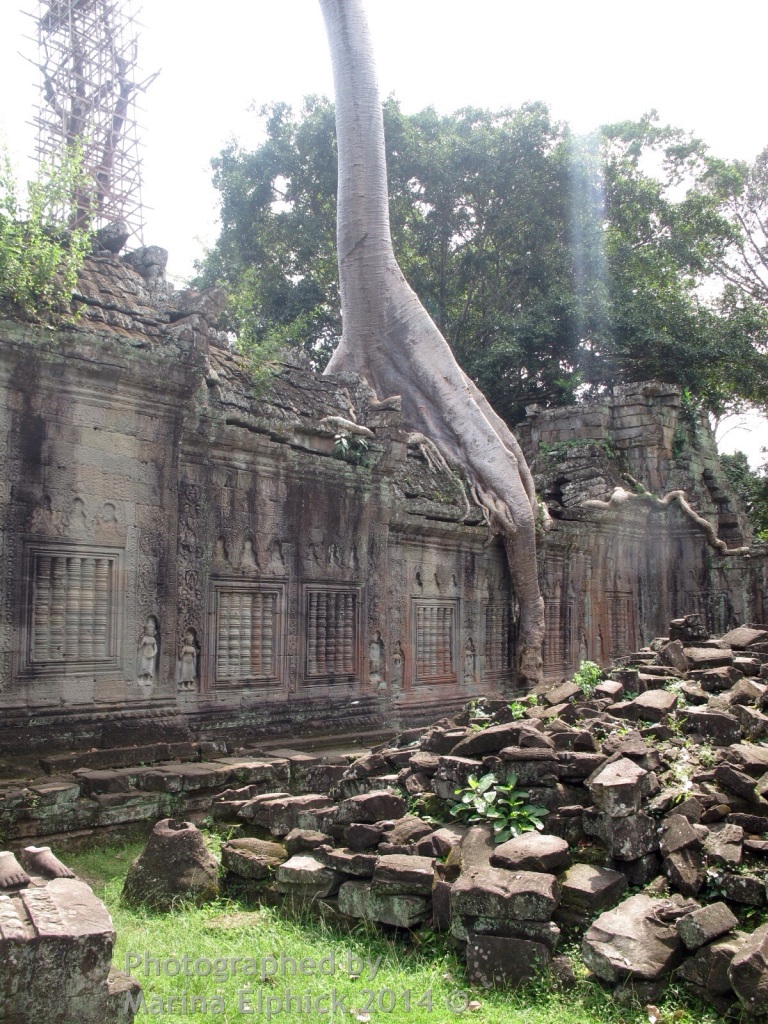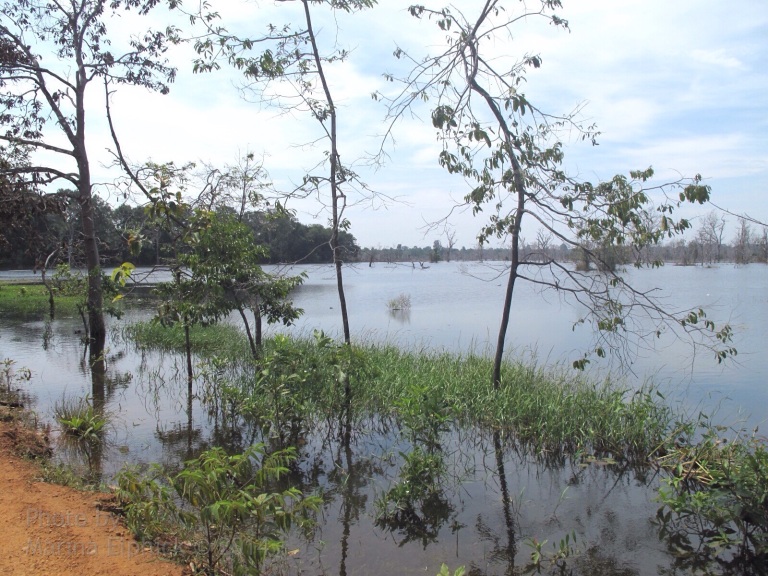The truly inspiring Temples of Ankor, Cambodia
In 1860, missionaries came across ruins in the Cambodian jungle—and discovered a lost city twice as large as Manhattan, New York. What an incredible thought, just imagine the exciting feeling of discovering somewhere so special !


My trip to Angkor, Cambodia with my husband Richard has been an exciting and amazing discovery for us, finding some Temples still virtually in the same condition as when they were first discovered.
Ta Prohm Temple

Ta Prohm Temple was built as a Buddhist monastery in the 12th century. It appeared to be the most ruined of all the Temples, visibly being strangled by trees and overgrown with huge creeping vines. The first sight was quite surreal; giant snake-like roots seemingly growing through the stone structures and silently squeezing the life out of them. The way nature has taken over Ta Prohm is spectacular and visually dramatic, but the damage that these strangling vines are causing is serious and has to be closely monitored.






Angkor Wat
Our next visit was to the stunning and famous Angkor Wat, built during the reign of King Suryavarman II in the early 12th century. It was first Hindu, later Buddhist and It was constructed following the model of the temple mountain symbolising Mount Meru, home of the Gods.


From a distance Angkor Wat appears to be a colossal stone building all on one level, with a long causeway leading to the centre, but close up it is a series of elevated towers, covered galleries, chambers, porches and courtyards on different levels linked by stairways.
It is set within a vast square moat, then a forest, after which a long, sand stone causeway leads to the stepped entrance. The outer wall, 1024 by 802 metres and 4.5 m high, is surrounded by a 30 metre border of open ground and a moat 190 metres wide.


Inside, the various chambers walls are covered with stone carvings and bas-reliefs depicting Hindu mythology and the wars the king fought during his reign. Ankor Wat has over 2000 Apsara dancers exquisitely carved throughout the numerous galleries and corridors.

It was easy to become overwhelmed by the scale of Angkor Wat and feel disorientated by the repetitive elements in the architecture; galleries with columns, towers, curved roofs, steps and the cross-shaped plan occur again and again. Good we had our guide, Leda with us, who knew her way around very well and was able to take us to the least busy parts enabling a few photographs without other tourists.


Angkor Thom
Angkor Thom was the last capital of the Great Khmer Empire under the reign of Buddhist King Jayavarman VII and it is surrounded by an 8 metre high wall built in a perfect square.

We entered the city through the ancient South gate, an impressive stone arch carved with elephants and four giant faces. On each side of the entrance path a row of 54 gods and demons held the giant sacred Naga snake, making our approach quite awe inspiring.



Bayon Temple

After a cooler walk through a forest we came to Bayon Temple, a 12th century masterpiece known for its 54 towers with enigmatic faces, representing the 54 provinces of the Great Khmer Empire. Each tower had four faces of Buddha facing outwards, and were carved on a monumental scale.








Terrace of the Elephants
Nearby were the Terrace of the Elephants and the Terrace of the Leper King. The Terrace of the Elephants is part of the walled city of Angkor Thom, and was used by Angkor’s king Jayavarman VII as a platform from which to view his victorious returning army. It was attached to the palace of Phimeanakas, which has not survived because it was primarily made of wood and organic material.

The Terrace of the Leper King is at the north end of the Terrace of the Elephant and had some amazingly intricate bas-relief sculpture, including the five headed horse and scenes of warriors and dancers.


The Terrace of the Leper King
There are many stories to why the name Leper King, it is said that King Jayavarman VII had leprosy, but this is disputed. The current name derives from a 15th-century sculpture discovered at the site. The statue depicts the Hindu god Yama, the god of death, however was called the “Leper King” because of discolouration and moss growing on it was reminiscent of a person with leprosy. Another explanation is that this statue would represent Yama, the god of the deaths, and the terrace would have been in fact a royal crematorium.

Preah Khan
Preah Khan was another stunning 12th century Buddhist Temple, slightly tumbled down, with nature doing its best to undermine it.





Preah Khan originally served as a religious university and a temple. The temple is still largely unrestored, the initial clearing was from 1927 to 1932, and partial renovation was carried out in 1939. Since then free-standing statues have been removed for safe-keeping, and there has been further consolidation and restoration work. Throughout, the conservators have attempted to balance restoration and maintenance of the wild condition in which the temple was discovered. They have continued the cautious approach to restoration, believing that to go further would involve too much guesswork, and prefer to respect the ruined nature of the temple.














NeakPean
At the end of our visit to the Grand circuit of Temples we visited the quiet Neak Pean, a Buddhist sanctuary and ancient health spa placed in the centre of an artificial lake.

A few thin trees struggle to survive and sway like reeds in the vast lake which had a narrow walkway for us to walk across.

The sanctuary was originally designed for medical purposes (the ancients believed that going into these pools would balance the elements in the bather and cure disease); it is one of the many hospitals that Jayavarman VII built and is based on the ancient Hindu belief of balance. Four connected pools represent Water, Earth, Fire and Wind.


Banteay Srey
Our final Temple visit was to the exquisitely beautiful Banteay Srey, dedicated to the Hindu God Shiva and considered the best preserved Temple in Cambodia.

It is the best preserved temple in Cambodia.
The 10th century Temple was built in Pink sand stone, which was harder than usual, enabling the fine carving to last for centuries. The buildings themselves were miniature in scale, unusually so when measured by the standards of Angkorian construction.

Banteay Srey is known as Citadel of Women and has many beautiful bas-relief carvings of divine Devatas, Godessess, celestial maidens and dancing Apsaras embellish the walls.

Banteay Srey is known as “citadel of women,” or “citadel of beauty”, probably related to the intricacy of the bas relief carvings found on the walls and the tiny dimensions of the buildings themselves.


It was a magical place, with numerous intricate carvings of Hindu gods and deities, on pediments columns and lintels. The subtle reds, pinks and orange were heightened by the afternoon sun giving the walls a warm glow.




Cambodia is changing fast, a new airport in Siem Reap is being planned for 2016-17, allowing direct international flights. This will step up the number of tourists filing through the ancient Temples of Ankor and will undoubtedly make a less authentic experience in the future.
Cambodia’s people are astounding, they have suffered the trauma of the Khmer Rouge regime but have picked themselves up and moved on, always friendly, helpful and welcoming.
I really admire them and their courage, they have contributed to making our trip truly enjoyable, a travel experience I will never forget.




An amazing documentary and incredible photographs all worthy of a travel brochure ready for publishing. Thank you for sharing your wonderful trip with us.
LikeLiked by 1 person
Exciting Marina! Stunning photographs!
LikeLiked by 1 person
Thank you so much Marina for documenting your travels in such a brilliant blog. Kevin and I can’t wait to meet up and hear all about it….and get some tips for our visit. Lots of love Sasha xxxx
LikeLike